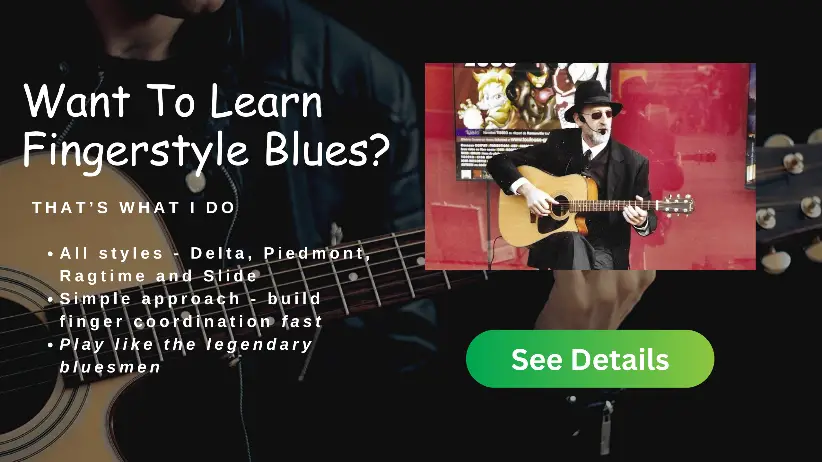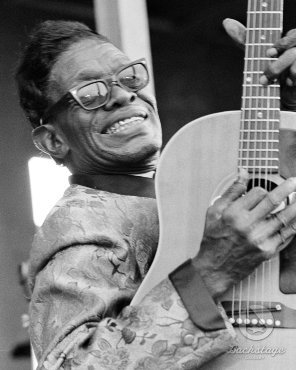This article appears in the May/June 2015 “Blues Issue,” now available on newsstands.
Listen, if you will, to the first 30 seconds of Lightnin’ Hopkins’ “Moanin’ Blues.” Listen to what happens when the weight of the world and love and loss is too much – if that all could form a pulse, a breath, a ratcheted rhythm, it would be this.
Even before his lips form more than a drawn-out “mmmm,” and even without ever touching on a chorus or repetitive, easy vamp, Hopkins breathes and plucks humanity. ‘I can’t hardly keep from crying,” he sings, with pulls of the strings cutting through like acid tears, the hollow of his guitar a quivering lip.
No one else can capture what life feels like – what it really feels like, in all its ache and sadness and uneasy humor – quite this way. Two and a half minutes of “Moanin’ Blues” and we know we all must moan the same: we all, really, get the blues.
“When you get a sad feelin’, you can tell the whole round world you’ve got nothin’ but the blues,” Hopkins says in the 1967 documentary The Blues According to Lightnin’ Hopkins, and he was the vessel for it.
Born Sam John Hopkins, he grew up on a cotton farm in Centerville, Texas, immersed in music from the likes of Alger “Texas” Alexander and other local luminaries – Blind Lemon Jefferson, known for his fast-picking and haunting howl, let the young boy play alongside him on a cigar box with chicken wire strings, becoming an early and deep influence.
He went on to develop a style that spoke its own complete language: you can’t describe Lightnin’ Hopkins as “bluesy” so much as you can describe Shakespeare as “Shakespearian.” He was the first and only of his kind.
When Lightnin' Hopkins died in 1982 at the age of 69, The New York Times called him “perhaps the greatest single influence on rock guitar players,” but the headline referred to him as “blues singer.”
That dichotomy says it all – Hopkins played the blues, but his musical style was as important to the evolution of rock and roll as Elvis’ hip shimmy.
The way his notes wrapped around the words, not went along with them, informed a whole generation of loose, freewheeling compositions unafraid of using an off-the-tracks rhythm – Jack White owes a lot to Led Zeppelin, but they both owe more to Hopkins, in the same way that so many modern musicians who drive their songs from a place of syncopated emotion, and not predictability, did. And do.
The dynamic crush of the Black Keys’ “I’m Not The One” rings pure to Hopkins’ roots, and bands as far ranging as the Red Hot Chili Peppers to Jimi Hendrix to Eric Clapton all owe licks to Lightnin’.
Hopkins made dozens of LPs on many different labels, but they were often just as indicative as he could be live – he rarely recorded multiple takes, and his improvisational style came through loud and clear.
Some call him country blues – whatever that means, really – something that Justin Townes Earle once showcased artfully in his cover of “My Starter Won’t Start,” which used the singer’s lead plucks to trace the meeting place between these two genres that, in their essences, sometimes aren’t as far apart as they might seem.
In fact, it’s Hopkins himself that is so difficult to define because his influence is so broad. Rock, blues, jazz, country.
It’s all built on his gut-wrenching performances, his heartbreaking lyrics that sometimes take a wink at themselves on his free-form discourse between the guitar and the singer.
It’s never quite clear, or important, really, whether it’s the vocal or the melody that’s driving a song; they talk with each other, play, push and pull.
Even a heavy-metal solo can find some roots in that – as can anyone who takes a left turn from traditional music patterns (12 bars are just the beginning), starts a song with a single-note lead or makes dissonant sounds scream poetry.
From traveling in his early days with Alexander to stints on the Chicago blues scene or the ’60s folk revival, Hopkins never wavered, never compromised, and influenced generations past and generations to come.
You can tell the whole round world you’ve got nothin’ but the blues, but no one told them like he did, and it’s quite possible no one ever will.
Article Source: https://americansongwriter.com/2015/05/lightnin-hopkins/


